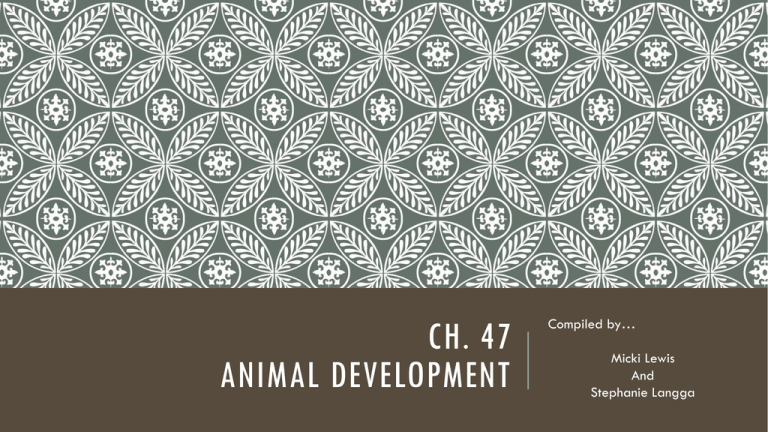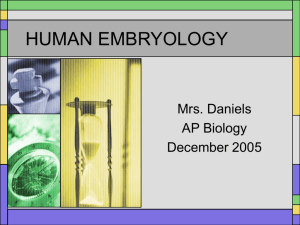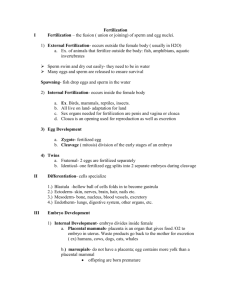Ch. 47 Animal Development
advertisement

CH. 47 ANIMAL DEVELOPMENT Compiled by… Micki Lewis And Stephanie Langga IN THE TH 18 CENTURY… Preformation •Idea that an egg or sperm contains an embryo, or “homunculus” that grows as it develops. Epigenesis •Idea that the form of an animal gradually comes from an egg - proposed originally by Aristotle …from watching a chick develop in its egg. *Displaced Preformation* MODERN TECHNOLOGY… …has enabled us to specify the stages of which human embryos develop. This one is at about 6-8 weeks after conception. •Cell Development - cytoplasmic determinants- proteins and RNA that also put together the genetic codes - differences emerge when uneven distribution appears between early embryonic cells •Cell Differentiation - specialization of cells in structure and function •Morphogenesis - when the organism takes shape and the cells go to their functional homes - Represent a larger group CONCEPT 47.1 After fertilization, embryonic development proceeds through cleavage, gastrulation, and organogenesis. FERTILIZATION •Important processes regulating development, a developing stage in most animals occurs 1. Cleavage cell division creates a hollow ball of cells, the blastula 2. Gastrulation rearranges blastula into a three-layered zygote, the gastrula 3. Organogenesis interactions with three layers create rudimentary organs FERTILIZATION Main Function Studied •Combining haploid sets from 2 organisms into a single diploid cell • SEA URCHINS!!! (zygote) - Not vertebrates or •contact with sperm on the egg’s chordates, but the characteristics surface “activates” metabolic are very similar. processes for embryonic ~ Deuterostome development Development •Contact, Autosomal reaction, … Eggs are fertilized Fusion of sperm and egg membranes, Cortical reaction, and externally. Entry of sperm. FERTILIZATION… IN SEA URCHINS Acrosomal Reaction • reaction between the sperm tip (the acrosome) and egg •The acrosome discharges hydrolytic enzymes •Hydrolytic enzymes digest jelly coat •Leads to the fusion of the sperm and egg plasma membranes *Fast block to polyspermy : depolarization of the egg’s membrane potential External Fertilization Cortical Reaction • fusion causes a longer-lasting polyspermy block • Cortical granules fuse to the egg plasma membrane for initiation • Fertilization envelope is formed from secretion of hardening enzymes *Slow block polyspermy : change of egg’s surface function that block other sperm This ensures that only one sperm enters the egg cytoplasm. Activation of the Egg • Egg Activation •Rise of calcium ions increases rates of cellular respiration and protein synthesis •OR, artificially activated by calcium ion injection (parthenogenesis) •About 20 minutes later… •Creation of diploid nucleus •Timing differs! •Different species have different times in meiosis and can stop in a stage until fertilization • Faster in sea urchins 90 min Mammal Fertilization •Moist environment •Sperm movement in female reproductive tract •Zona Pellucida • After going through follicle cells, the sperm reaches the cellular matrix of the egg (part sperm receptor) • Binding induces acrosomal reaction •Afterwards… • NO fast block to polyspermy • Whole sperm is taken into egg • Slower in mammals 12-36 hours Internal Fertilization 1. CLEAVAGE • rapid cell division WITHOUT growth • goes from the zygote into many smaller cells, or blastomeres •Follows a specific pattern •Fluid-filled cavity forms, blastoecoel, in the first five-seven divisions •Fully forms into the blastula, a hollow ball of cells *Polarity of eggs and zygotes established as the egg develops. Defined by uneven distribution of cytoplasmic substances 1.5 CLEAVAGE • Holoblastic Cleavage Yolk: stored nutrients - Key factor in influencing the pattern of cleavage - Often concentrated toward one pole: - Vegetal pole •Division of the entire egg - Decreases significantly toward the •Occurs in species with eggs that have moderate amounts of yolk animal pole, where polar bodies bud from the cell • EX. sea urchins, frogs, and mammals •Meroblastic Cleavage •Incomplete division of the egg •Occurs in species with yolk-rich eggs • EX. birds and reptiles • Most animals have a dramatic rearrangement of cells. 2. GASTRULATION • Transforms blastula into a gastrula • Cells near the blastula form three cell layers, or germ layers : 1. Ectoderm The outer layer 2. Endoderm The lining of the embryonic digestive tract 3. Mesoderm Space between the ectoderm and endoderm 3. ORGANOGENESIS • involves more localized shape changes in tissues and individual cells • First evidence of organ building: appearance of tissue folds, splits, and dense clustering of cells • Notochord • Skeletal rod characteristic of ALL chordate embryos • Neural Tube • The rolled neural plate, caused by cell shape change • Neural Crest Cells (in vertebrates) • Pinched off neural crest that migrates to parts of the embryo to form nerves, teeth, bone, etc. • The “fourth germ layer” • Somites • Mesoderm lateral to the notochord that separate into blocks, arranged along the notochord AMNIOTES Developmental Adaptations of Amniotes • embryos of birds, reptiles, and mammals • Or amniotes • Develop within a fluid-filled sac called the amnion in a shell or the uterus • Also forms extraembryonic membranes 1. Chorion – gas exchange 2. Amnion – protective, fluid-filled cavity 3. Yolk Sac – encloses yolk for nutrients 4. Allantois – disposes waste products Mammalian Development • Placental Mammals •Eggs are small and have few nutrients • Holoblastic cleavage • No polarity *similar pattern to birds and reptiles* Human early embryonic development goes through 4 stages MAMMALIAN DEVELOPMENT • after fertilization and cleavage… 1. Blastocyst (version of a blastula) implants in the uterus. Inner cell mass develops into the embryo and form the extraembryonic membranes 2. Trophoblast (outer epithelium of the blastocyst) supports the embryo but DOES NOT actually contribute to the embryo itself. (formation of the fetal position) 3. The embryo develops from the epiblast and hypoblast within the blastocyst. CONCEPT 47.2 Morphogenesis in animals involves specific changes in cell shape, position, and adhesion. MORPHOGENESIS • major aspect of development in animals AND plants •Only involves movement in cells of animals •Can bring changes in shape or migration •Plants cannot move; rigid cell wall •Changes in cell shape and cell position are in cleavage, gastrulation, and organogenesis. CELLULAR COMPONENTS & BEHAVIOR Cytoskeleton, Cell Motility, and Convergent Extension Rearrangements change both the shape and position of the cells. •Both occur in tissue invaginations •Convergent Extension: a type of morphogenetic movement where cells of a tissue rearrange themselves that it becomes narrower and longer. Role of Cell Adhesion Molecules and Extracellular Matrix 1. Cell Adhesion Molecules • hold cells together in tissues Ex. Cadherins 2. Extracellular Matrix • Fibers provide anchorage for cells •Guides migrating cells to destinations *important intracellular molecules: Fibronectin and glycoproteins CONCEPT 47.3 The developmental fate of cells depends on their history and on inductive signals. PRINCIPLES OF DIFFERENTIATION First… Second… During early cleavage divisions, embryonic cells must become different from one another. Once initial cell asymmetries are set up, subsequent interactions among the embryonic cells influence their fate, usually by causing changes in gene expression. In many animals, the first differences result from uneven distribution of cytoplasmic determinants. (transcription factors like DNA binding proteins that activates one set of genes) • Induction: • mechanism that brings differentiation of the specialized cell types that make up an animal FATE MAPPING -maps of embryos that show specific regions that develop into specific parts • development in specific parts of OLDER embryos • EX. lineage of C. elegans ESTABLISHING CELLULAR ASYMMETRIES In nonamniotes… •need unevenly distributes cytoplasmic determinants in the egg •Establish body axes •Difference between blastomeres from cleavage in the zygote - Differences matter! •Undergo different fates with different cytoplasmic determinants In amniotes… •Local environmental differences •Also establish initial differences of cells and body axes Totipotent: - Capability of developing into all different cell types of a species •Development potential •As embryonic development proceeds, developmental potential of cells become limited INDUCTIVE SIGNALS Cell Fate Determination Cells in developing embryo receive and respond to positional information. • Dorsal Lip of blastopore in the gastrula functions as an organizer (or Spemann’s organizer, gastrula organizer) • Or AER (apical ectodermal ridge) and ZPA (zone of polarizing activity) of the vertebrate limb bud • Inductions form the notochord, neural tube, and organs Pattern Formation Development of an animal’s spatial organization Arrangement of organs and tissues in 3D space • Control Pattern Formation • Tells a cell where it is relative to the body axes •Determines how the cell will respond to molecular signaling REFERENCES AP Biology book Bozeman Animal Development Video Crash course Animal Development







